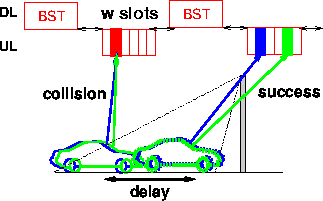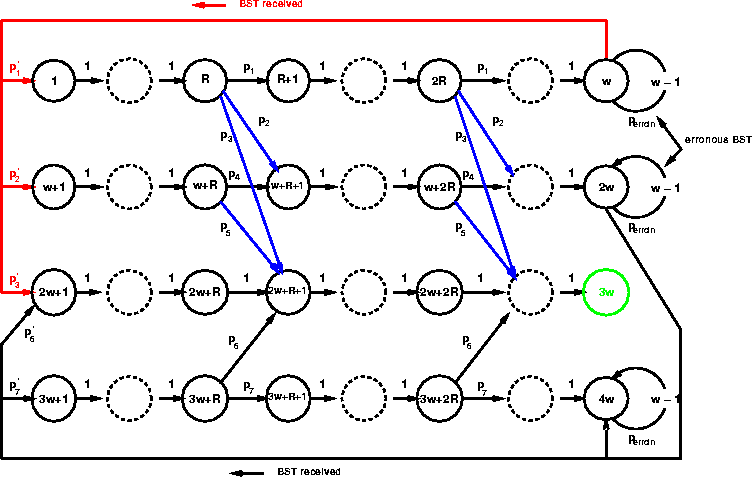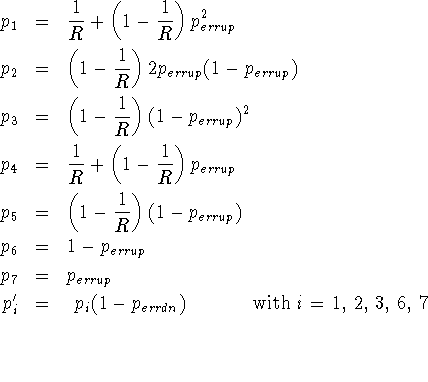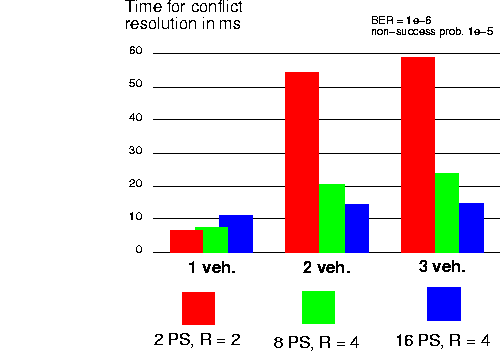
 |
JPL's Wireless Communication Reference WebsiteChapter: Network Concepts and Standards
|
A key problem in vehicle-roadside communications is the multiple access interference during the address acquisition phase: the vehicle, which enters the communication zone, needs to access the communication channel simultaneously with other vehicles, which may lead to data collisions and access delays (see figure 7).

Figure 7: Data collision resolution for two
simultaneously arriving vehicles
The address acquisition phase (or also connection phase) is initiated
by the beacon by transmitting periodically a BST (Beacon Service
Table). Following a BST, w time slots are offered to the newly
arriving vehicles. An appropriate contention mechanism (using a
Random Delay Counter, which allows to select one time slot randomly
from a given number of R time slots) ensures, that data collisions
and the associated delay of simultaneously arriving vehicles can be
reduced to a minimum.
Using a Markov chain modelling approach, it is
possible to describe the process of the data exchange between the
roadside station and one or more vehicles. From the model the
transaction success probability of a vehicles can be calculated
depending on the used transaction time. The models can take into
account the arrival rate and speed of vehicles, the behaviour of the
medium access protocols, the characteristics of the transaction
process following the address acquisition phase and the impact of the
channel characteristics. Detailed descriptions of these analytical
approaches can be found in
[5, 14, 4].

Figure 8: Markov state transition model (2 vehicles,
Random Delay Counter)
An example of a model with a selected parameter set (see
figure 8) is used here to demonstrate the usage of the
Markov modelling for a particular application:
the model describes the address acquisition phase for different
values for the max. Random Delay Counter R and the number of offered
time slots w. The model takes into account downlink and
uplink packet error rates ( ![]() ,
, ![]() ). With each state
transition a time step of 0.16 ms is associated.
). With each state
transition a time step of 0.16 ms is associated.
The state transition probabilities corresponding to the model depicted in figure 8 are given by:

With the presented model it is possible to compare the behaviour of the contention mechanism for various parameter sets (variable number of access slots) and traffic situations (simultaneous arrival of single and multiple vehicles) as shown in figure 9.

Figure 9: Access delay for different scenarios
The results indicate, that using only 2 public slots, fast access for the single vehicle situation is ensured, whereas in situations with multiple vehicles considerable delay is encountered. Assuming a vehicle speed of 60 m/s and a typical length of the communication zone of 6 m, only 100 ms are available for a complete transaction. Therefore the connection times of more than 50 ms are not acceptable, less than 25 ms is recommendable. With 6 or even 16 public slots and a corresponding Random Delay Counter of 3 or 4, the connection time delay for multiple vehicle situations is reduced considerably. Although there is a slightly enhanced delay for the single vehicle encountered, at least a Random Delay Counter of 3 (and preferably 6 public slots) is recommendable for systems having to cope with simultaneous access to the same communication channel.
Although the analytical approaches are an important element of the evaluation process, not all effects, such the channel characteristics, can be taken into account in detail without meeting complexity limits. Therefore simulation techniques need to be considered to evaluate the performance of DSRC systems in a realistically modelled environment (see 8).